Engagement Ring - In Progress
Setting
Stone
Limited Time! Purchase any Engagement Ring and Receive a $250 Gift Card & Premier VIP Bundle.
We guarantee that every single purchase directly impacts one person's life by giving them access to clean water.
Want to know more? Read on!

(left) washed out; (middle) even contrast/brilliance oval; (right) too much contrast
Too much dark contrast in the center of your oval cut diamond that looks like a black bowtie is just not attractive, avoid it! Likewise, watery, washed out bowties are not very pretty either. You want a bowtie area with even contrast and brilliance (there it is again!) I receive oval diamond bowtie questions all the time, and there’s a lot of misinformation out there about them – let’s get it straightened out.

(left) watery bowtie; (middle) well balanced bowtie area; (right) dark bowtie
Yes, all oval cut diamonds have bowties. Though like James Bond’s vs Bill Nye’s, some are simply better than others. An oval cut diamond’s bowtie is in its middle, as a result of this cut’s nice long length! Necessarily, oval facets are shorter width wise, and longer length wise. Thus, an oval diamond’s middle will always look different than its tips! It wears a bowtie!
A diamond bowtie occurs when width facets are shorter and are steeper than its length facets. These differences in depth and angles cause light to refract differently in an oval’s center vs its tips. So, if a cutter is not careful, those deep center facets can turn into a dark oval diamond bowtie! But there’s hope! Skilled diamond cutters will avoid dark bowties and also include well placed contrast throughout the stone to make an even appearance.
Yes, an overly dark bowtie, or a watery bowtie, can look pretty bad. The goal is to look for a stone in which the cutter has blended the bowtie in. This means looking for a stone that has both contrast and brilliance not only in the bowtie area, but also in the tips.
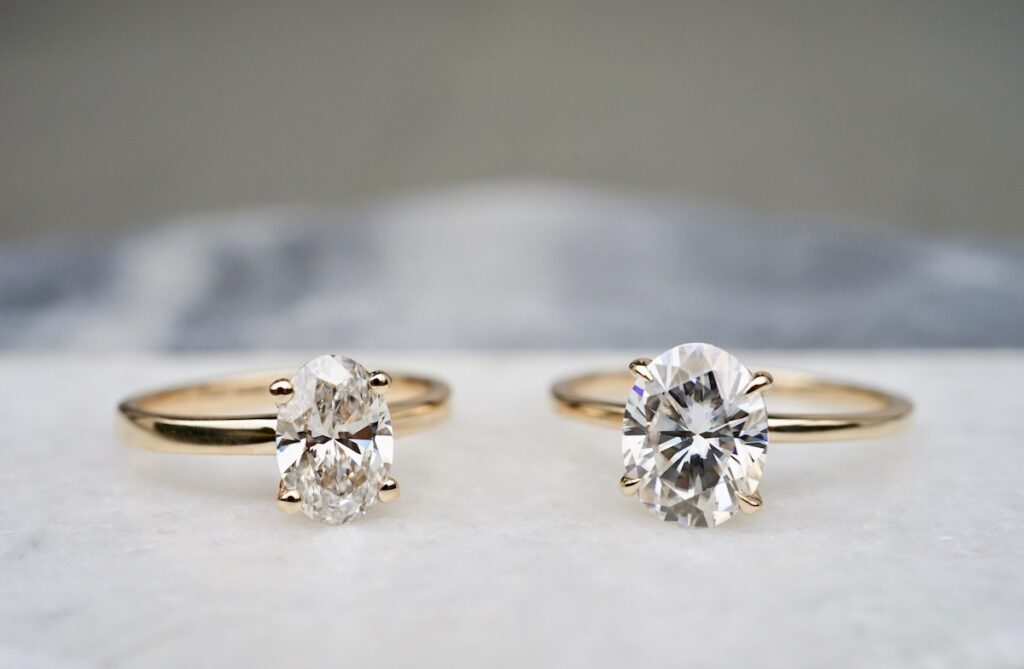
Oh, you fancy, huh? Oval diamonds are considered “fancy” shapes – and for good reason! There’s several different shape considerations and cutting styles to choose from! End (or “tip”) style, pavilion main (I like to call this “star ray”) style, length ratio, and shoulder curve…the list goes on! Check it out:
An oval diamond’s “tips” (also called “ends“) are the soft round arcs at each end! These tips can be cut with one larger diamond shaped facet, or can be faceted with several! While I do not necessarily recommend one over the other, two things are for certain: avoid dark or overly colored tips.
Dark tips take away from the beauty of your stone. This most frequently occurs in diamonds with one flat facet on each tip, and very infrequently in stones with multi-faceted tips. That’s because it’s easier to break up overly dark contrast with more facets at more angles. This doesn’t mean you should throw out all ovals with single facet tips – just to learn what to look for. Watch the 360 video of your stone closely – do the tips look dark as it spins? If so, reject it! Dark tips take away from sparkle and brilliance.

Dark oval tips (left); bright clear oval tips (middle); color concentration in oval tips (right)
Don’t buy a diamond with more warmth in its tips than its center. Because diamond tips are shallower than its middle (and thus have less opportunity to refract light), they often show more color. So, while you’re looking at that beautiful spinning sparkler, take a look at the color of the tips compared with its belly. Are they the same? Or is there a concentration of warmth in the tips? If the tips look warmer than the rest of the diamond, pass. Color consistency is key!
Ovals can be cut with 4, 6, or 8 pavilion mains (which look like 4, 6, or 8 rayed stars). One cutting style is not better than another, it is personal preference! Some people prefer the look of a 4 ray which has big bold facets, others like the interesting pattern of the 6 (6s are rare!), and many prefer the added liveliness and pinfire bling of an 8 (this is the most widely cut). Check them out here, which is your favorite?
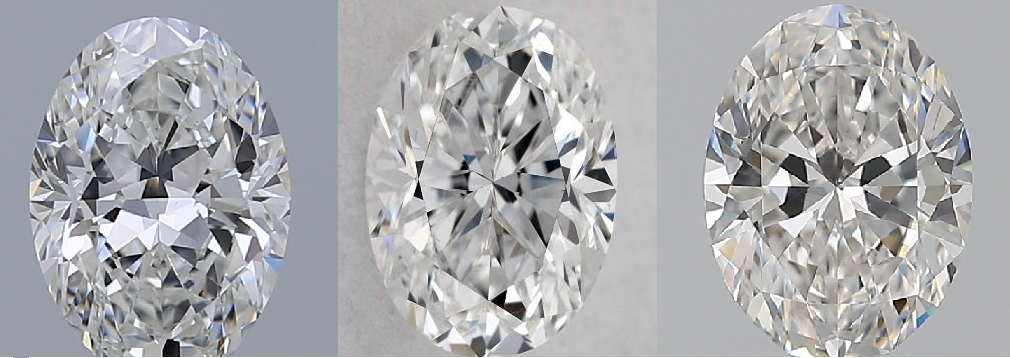
4, 6, and 8 pavilion main diamonds
Choosing a graceful shoulder curve boosts both beauty and value. A diamond’s shoulder curve is the arc between its belly (its bowtie area) and its tips. An ideal oval cut diamond shoulder is soft and curving. However, shoulders can also look flat (approaching a marquise look) or square/heavy (approaching an elongated cushion appearance). So, take some time and look at the outline of your oval. Is it soft and appealing? Or does it feel bulky or overly harsh? You’re choosing an oval for its shape – so pick one you like!
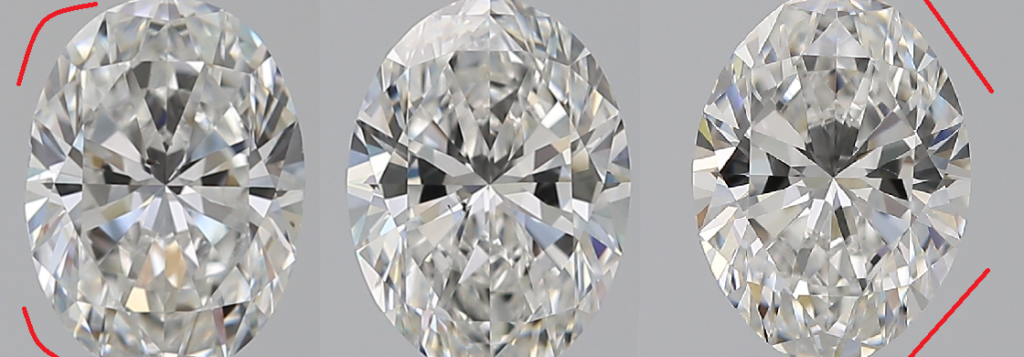
(left) bulky shoulders; well proportioned oval; flat shoulders (right)
Length to width ratio shows you how long and skinny or wide and plump your oval cut diamond will be. While it sounds kind of technical and complicated, it is actually only the length measurement of a diamond divided by its width. That’s it!
Most people say the ideal length-to-width ratio of an oval is 1.35-1.50. Diamonds that fall within this range will not be too round, or too pointy! The lower the ratio, the plumper the oval. Likewise, the higher the ratio, the skinnier! One perk of a higher length-to-width oval ratio is that skinny ovals appear larger than their carat weight due to their length. However, it all comes down to personal preference. Some people prefer rounder ovals (at its extreme, we call it a roval – a round oval) while the opposite extreme prefers a very tall, thin oval (we call his a moval – a marquise oval). These outliers can have a lot of character!

1.35, 1.40, 1.45, and 1.50 length-to-width ratios
Nothing is worse than a perfect-on-paper oval that’s littered with random weird reflections. Ok, there’s probably a few worse things, but still, the point stands. So, to get the most beautiful oval, you have to know what you’re looking for. A fisheye is when a diamond’s girdle (it’s very outside edge) reflects awkwardly under its table, making a ghostly white ring. It’s not very attractive – nix them! Additionally, due to their length, oval cut diamonds can show other odd reflections, too. So while you’re watching that diamond spin – look under the table (the big top facet). Are there weird reflections that mess with your sparkle? Pass! The best ovals will have crisp, clean facets showing – you guessed it – even brilliance and contrast.

Fisheyes and odd reflections in oval cut diamonds
You betcha! I love ovals – and so does Krish, our founder, he proposed with one! Write to either (or both!) of us at care@doamore.com and we will custom curate a selection of stunning ovals for you to choose from – all with max bang for your buck!
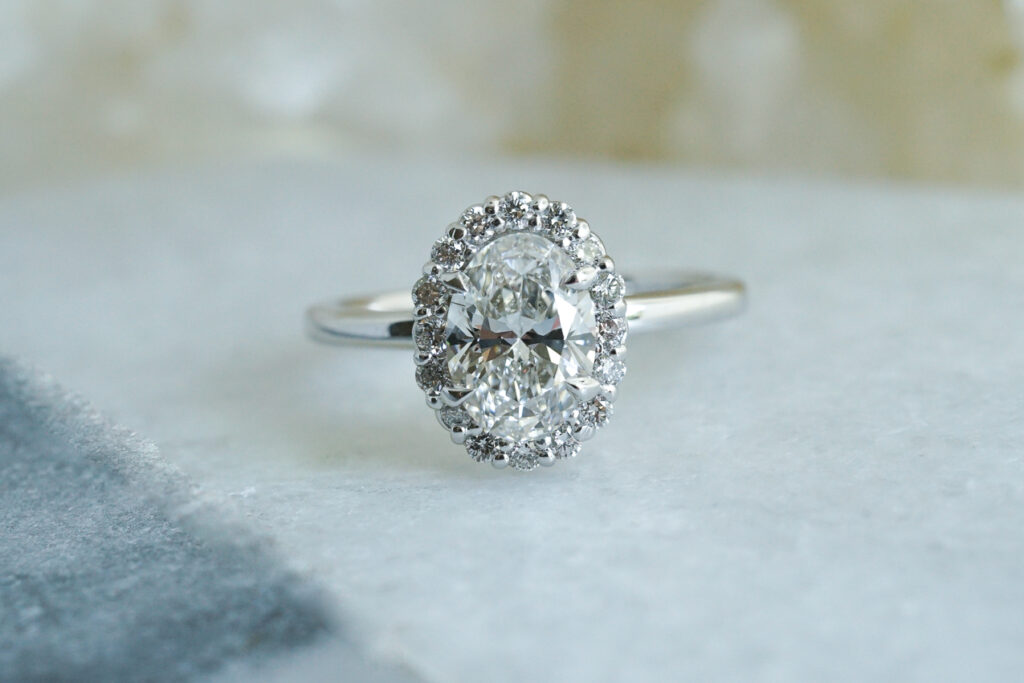
Verifiably Ethical & Sustainable
Guaranteed 1:1 Impact
Personalized 1:1 Customer Service
handcrafted & american-made
you before us, always
Verifiably Ethical & Sustainable
Guaranteed 1:1 Impact
Personalized 1:1 Customer Service
handcrafted & american-made
you before us, always
Thoughtfully crafted, made to last, and designed for life's most meaningful moments. LEARN MORE
Diamonds, Gemstones, & Metals
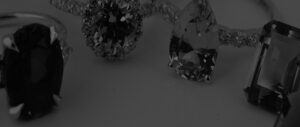
Every piece of Do Amore jewelry begins by not hurting the world. All our natural diamonds are either ethically sourced in Canada, recycled to eliminate additional demand, or accompanied by a blockchain ledger showing every hand your diamond passed through, proving your stone is truly conflict-free.
We also offer sustainable lab-created stones and guarantee all precious metals are recycled to eliminate the environmental impact of mining. Since March 2022, we carry absolutely no Russian diamonds and continue to urge the industry to follow suit.
Clean Water
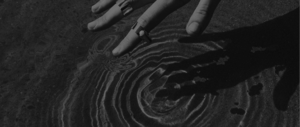
We desire to deepen the well of love in the world. We guarantee that every single purchase—whether engagement ring, wedding band, or piece of jewelry—directly impacts one person’s life by giving them access to clean water.
We do this by directly matching jewelry purchases to people in communities to ensure our funding has a one-to-one impact. We also show you the exact GPS coordinates and a photo of the water well your ring or piece of jewelry helped fund.
Customer Service
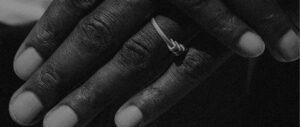
As a small, 100% founder- and employee-owned team, one-to-one encounters are at the heart of our values. Whichever way you want support throughout your engagement ring or jewelry purchase process, our team is here to accommodate you.
From high-touch to hands-off, video calls to text messages, you have our dedicated, responsive team on your side from the moment you start your search, to the day your well is built, to the time we meet again.
Engagement Rings, Bands, & Jewelry
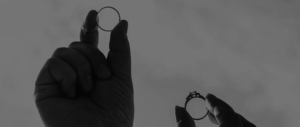
Every Do Amore design, whether one of our own or unique to you, is beautifully handcrafted in America and made specifically for you. Each ring is made to order, every time.
From classic to custom, you have the option to select from dozens of gorgeous settings or work with our design team to create something entirely bespoke. Plus, you are always covered for free inspections, polishing, cleaning, stone tightening, rhodium-plating, and resizing for life.
Our Promise

We care about what matters most to you, not what’s easiest for us. If it’s a minor change to a setting or arriving at a completely custom design, we work to ensure you get precisely what you love.
From statement-making to understated, we have options at any price point. Plus, you always have our team on your side searching to bring you every stone within your specifications. We also offer 60-day returns and a limited lifetime warranty to cover you in the rare event of a manufacturing defect.